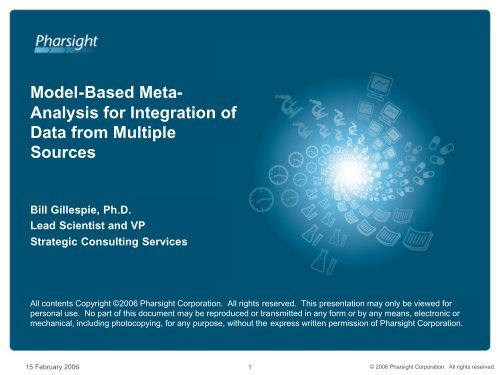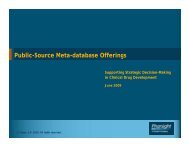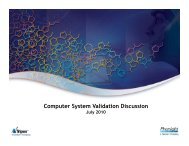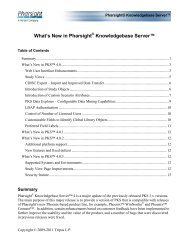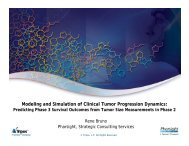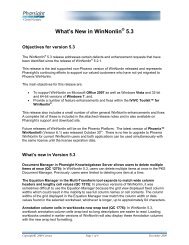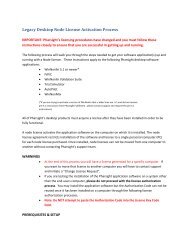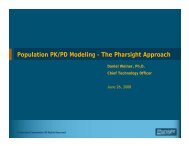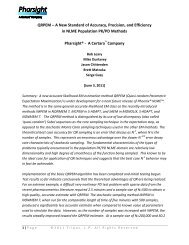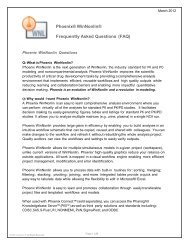Model Based Meta Ana.. - Pharsight Corporation
Model Based Meta Ana.. - Pharsight Corporation
Model Based Meta Ana.. - Pharsight Corporation
You also want an ePaper? Increase the reach of your titles
YUMPU automatically turns print PDFs into web optimized ePapers that Google loves.
<strong>Model</strong>-<strong>Based</strong> <strong>Meta</strong>-<br />
<strong>Ana</strong>lysis for Integration of<br />
Data from Multiple<br />
Sources<br />
Bill Gillespie, Ph.D.<br />
Lead Scientist and VP<br />
Strategic Consulting Services<br />
All contents Copyright ©2006 <strong>Pharsight</strong> <strong>Corporation</strong>. All rights reserved. This presentation may only be viewed for<br />
personal use. No part of this document may be reproduced or transmitted in any form or by any means, electronic or<br />
mechanical, including photocopying, for any purpose, without the express written permission of <strong>Pharsight</strong> <strong>Corporation</strong>.<br />
15 February 2006 1<br />
© 2006 <strong>Pharsight</strong> <strong>Corporation</strong>. All rights reserved.
<strong>Model</strong>ing and simulation of clinical outcomes via<br />
integration of heterogeneous data<br />
• Objective<br />
– Provide an introduction to modeling and simulation<br />
of clinical outcomes via meta-analysis of data from<br />
heterogeneous sources, e.g., individual patient data,<br />
summary data on clinical outcomes from public<br />
sources and pre-clinical data.<br />
• Outline<br />
– Rationale<br />
– Data collection and modeling process<br />
– 2 case studies illustrating the use and value of<br />
model-based meta-analysis in clinical drug<br />
development<br />
– Brief discussion of issues relevant to model-based<br />
meta-analysis<br />
15 February 2006<br />
2<br />
All contents © 2006 <strong>Pharsight</strong> <strong>Corporation</strong>. All rights reserved.
Rationale for model-based meta-analysis<br />
• Why build models via integration of heterogeneous data?<br />
– Leverage prior knowledge from all available sources<br />
• Data on the NCE of interest<br />
– Preclinical, Phase I safety & biomarkers, clinical safety & efficacy …<br />
• Knowledge about the target disease & affected physiologic systems<br />
• Knowledge/data on related compounds<br />
– From proprietary or public sources<br />
– <strong>Ana</strong>logs or competitors<br />
– Comparison of competing drugs/treatments<br />
• Borrow information<br />
• Shared model parameters are more precisely estimated<br />
• Comparative inferences are also more precise<br />
– Prediction of unobserved clinical outcomes<br />
• Build models for preclinical-to-clinical or biomarker-to-clinical relationships<br />
• Use those models to predict clinical outcomes for NCE’s for which no<br />
clinical data is available<br />
15 February 2006<br />
3<br />
All contents © 2006 <strong>Pharsight</strong> <strong>Corporation</strong>. All rights reserved.
Taxonomy of data and data sources<br />
• Data information level<br />
– Summary data<br />
• Summary statistics such as treatment mean, sample size, fraction<br />
of patients that experience an event, etc.<br />
– Individual patient data<br />
– Endpoint data<br />
• Usually LOCF or OC<br />
– Longitudinal data<br />
• Data observed at multiple times within each patient<br />
• May be available as either summary or individual patient data<br />
• Data at early time points may be viewed as biomarkers for later<br />
outcomes<br />
• May allow modeling strategies to adjust for biases in LOCF or OC<br />
data<br />
15 February 2006<br />
4<br />
All contents © 2006 <strong>Pharsight</strong> <strong>Corporation</strong>. All rights reserved.
Taxonomy of data and data sources<br />
• Source of data<br />
– Proprietary<br />
• Individual patient data from clinical trials<br />
• Preclinical data<br />
– Public domain<br />
• Journals<br />
• Regulatory documents, e.g., FDA “SBA’s”<br />
– http://www.accessdata.fda.gov/scripts/cder/drugsatfda/<br />
• Published abstracts<br />
• Posters, slides or other documents presented to the public at meetings<br />
• Web documents, e.g., press releases about new clinical trial results<br />
• Clinical trial registries<br />
– http://www.clinicalstudyresults.org/<br />
– http://www.clinicaltrials.gov/<br />
– http://ctr.gsk.co.uk/welcome.asp<br />
– http://www.lillytrials.com/<br />
– http://www.roche-trials.com/results.html<br />
15 February 2006<br />
5<br />
All contents © 2006 <strong>Pharsight</strong> <strong>Corporation</strong>. All rights reserved.
Taxonomy of data and data sources<br />
• Type of data<br />
– Preclinical data<br />
• In vitro<br />
• In vivo<br />
• Pharmacokinetics<br />
– Clinical data<br />
• Pharmacokinetics<br />
• Biomarkers<br />
• Clinical efficacy/safety data in target patient population<br />
15 February 2006<br />
6<br />
All contents © 2006 <strong>Pharsight</strong> <strong>Corporation</strong>. All rights reserved.
The process<br />
• Establish a collaborative relationship with the development team<br />
– What decisions are they facing, e.g.,<br />
• Design of next trial<br />
• What treatment regimen(s) (dose, frequency, route, etc.)<br />
• Go/no-go<br />
• What indication(s)<br />
– Identify their key issues, dilemmas and uncertainties<br />
– Identify where modeling and simulation can enhance their decisionmaking<br />
• By more effectively leveraging prior information<br />
• By making assumptions explicit and quantitative<br />
• Plan your modeling strategy<br />
– Develop a modeling work plan, e.g., objectives, data required,<br />
methodology,…<br />
– Tailor the plan to the specific objectives, e.g., don’t try to develop models<br />
to address all potential future objectives<br />
– Prioritize objectives to maximize value to the development program<br />
15 February 2006<br />
7<br />
All contents © 2006 <strong>Pharsight</strong> <strong>Corporation</strong>. All rights reserved.
The process<br />
• Identify key information you want to collect<br />
– Clinical endpoints<br />
• Type of data needed: summary data, patient data, …?<br />
• For summary data, what summary stats to collect?<br />
– Potential preclinical or clinical predictors (biomarkers)<br />
– Drugs<br />
– Covariates of potential interest or explanatory value<br />
– Relevant mechanistic knowledge<br />
– Prior modeling work relevant to the project<br />
• Construct a database<br />
– Establish a consistent process including quality control measures<br />
– Finding the sources<br />
• Public sources<br />
– Literature search<br />
– Web search<br />
– FDA web site<br />
– Clinical trial registries<br />
• Proprietary sources<br />
– Preclinical and clinical data on NCE of interest<br />
– Preclinical and clinical data on previous NCE’s studied for same indication<br />
15 February 2006<br />
8<br />
All contents © 2006 <strong>Pharsight</strong> <strong>Corporation</strong>. All rights reserved.
The process<br />
• Construct a database (cont.)<br />
– Compiling the public source database<br />
• Review a subset of the data sources to assess<br />
– Range of data presentation, e.g., mean, mean change from baseline,<br />
percent change from baseline, etc.<br />
– Availability of data and covariates<br />
• Adjust modeling and data gathering plan as necessary<br />
– Is there enough data to support modeling?<br />
– Are other related quantities reported?<br />
• Plan the structure of the database<br />
– Platform: ASCII, spreadsheet, relational database, etc.<br />
– Format: nomenclature, multiple data columns vs. one data column with<br />
column containing data label, missing data handling, etc.<br />
• Enter the data<br />
• QC<br />
• Execute the modeling work plan<br />
15 February 2006<br />
9<br />
All contents © 2006 <strong>Pharsight</strong> <strong>Corporation</strong>. All rights reserved.
• <strong>Meta</strong>-analysis of mean LDL-C % change from baseline<br />
• 25 clinical trials<br />
– 13 trials of statin monotherapy<br />
– 4 trials of ezetimibe monotherapy<br />
– 4 trials of statin/ezetimibe combinations<br />
– 3 trials of gemcabene monotherapy<br />
– 1 trial of statin/gemcabene combinations<br />
• The original work also included modeling of CRP, headache, ALT<br />
elevation, myalgia, HDL-C and CHD relative risk<br />
• Key question: Can gemcabene/statin compete favorably with<br />
ezetimibe/statin?<br />
15 February 2006<br />
10<br />
All contents © 2006 <strong>Pharsight</strong> <strong>Corporation</strong>. All rights reserved.
Statin dose-response: monotherapy and combination with<br />
ezetimibe 10 mg/d<br />
15 February 2006<br />
11<br />
All contents © 2006 <strong>Pharsight</strong> <strong>Corporation</strong>. All rights reserved.
Incremental effect of gemcabene decreases with increasing<br />
statin doses<br />
15 February 2006<br />
12<br />
All contents © 2006 <strong>Pharsight</strong> <strong>Corporation</strong>. All rights reserved.
Statin/gemcabene<br />
is inferior to<br />
statin/ezetimibe at<br />
higher statin doses<br />
15 February 2006<br />
13<br />
All contents © 2006 <strong>Pharsight</strong> <strong>Corporation</strong>. All rights reserved.
Conclusion: Terminate the development program<br />
because gemcabene cannot compete favorably with<br />
ezetimibe as combination therapy with statins<br />
15 February 2006<br />
14<br />
All contents © 2006 <strong>Pharsight</strong> <strong>Corporation</strong>. All rights reserved.
Trial simulation to design a Phase II dose finding<br />
strategy<br />
• Phase II objective: Efficiently find a dose of drug<br />
X that:<br />
– Is at least non-inferior to the standard of care (drug R 10 mg/d)<br />
with respect to both efficacy and safety.<br />
– With sufficient certainty that we can risk a Phase III program with<br />
only one dose level.<br />
• Efficacy<br />
– Decrease in fraction of patients with a disease-related event<br />
• Probable dose-limiting AE<br />
– Same biological mechanism as efficacy<br />
15 February 2006<br />
15<br />
All contents © 2006 <strong>Pharsight</strong> <strong>Corporation</strong>. All rights reserved.
Trial simulation to design a Phase II dose finding<br />
strategy<br />
• Available information:<br />
– Drug X:<br />
• Clinical pharmacokinetics from Phase I.<br />
• Pre-clinical response thought to be predictive of clinical outcomes<br />
related to mechanism of action (both efficacy and dose-limiting AE)<br />
– Data for drug X and competitors<br />
– Public-source data:<br />
• 5 marketed drugs, 27 clinical trials, 77 treatment arms<br />
• Disease-related events<br />
– Number of patients with events & total number of patients for each<br />
treatment arm<br />
• Dose-limiting AE’s<br />
– Number of patients with events & total number of patients for each<br />
treatment arm<br />
• Pharmacokinetics<br />
– Mean clearance<br />
• Two categories of patients known to have different risks for both<br />
disease events and AE’s (designated group 1 and group 2)<br />
15 February 2006<br />
16<br />
All contents © 2006 <strong>Pharsight</strong> <strong>Corporation</strong>. All rights reserved.
<strong>Model</strong>ing strategy: Simultaneously model pre-clinical<br />
response, and frequency of clinical efficacy and AE events<br />
<strong>Model</strong> concentration-response<br />
for pre-clinical response<br />
Drug D Drug R Drug X<br />
<strong>Model</strong> relationships between<br />
pre-clinical & clinical potencies<br />
8<br />
10<br />
preclinical response<br />
Drug A Drug B Drug C<br />
log(EC) for disease event prevention<br />
6<br />
4<br />
2<br />
0<br />
Drug D<br />
Drug B<br />
Drug C<br />
Drug A<br />
Drug R<br />
log(EC) for AE<br />
8<br />
6<br />
4<br />
2<br />
Drug D<br />
Drug B<br />
Drug C<br />
Drug A<br />
Drug R<br />
-2<br />
Drug X (median &<br />
90% prediction interval)<br />
0<br />
Drug X (median &<br />
90% prediction interval)<br />
4 5 6 7 8 9<br />
4 5 6 7 8 9<br />
fraction of trials where Pr(disease event) & Pr(AE) at the<br />
selected dose is < 1.25 that for Drug R<br />
0.0 0.2 0.4 0.6 0.8 1.0<br />
0.49<br />
210<br />
630<br />
log-spaced<br />
1050<br />
210<br />
630<br />
1050<br />
15 February 2006<br />
log(concentration)<br />
210<br />
630<br />
number of patients<br />
linear-spaced<br />
5 doses 7 doses 5 doses 7 doses<br />
0.73<br />
0.82<br />
0.54<br />
0.72<br />
0.84<br />
0.52<br />
0.67<br />
0.73<br />
1050<br />
0.46<br />
210<br />
0.72<br />
630<br />
0.75<br />
1050<br />
fraction of trials where Pr(disease event) & Pr(AE) at the<br />
selected dose is < 1.25 that for Drug R<br />
0.0 0.2 0.4 0.6 0.8 1.0<br />
without<br />
with<br />
number of patients<br />
210<br />
630 1050<br />
without<br />
analysis method: modeling with or without prior information<br />
Optimize trial design and analysis<br />
via clinical trial simulations<br />
0.54<br />
0.77<br />
0.72<br />
0.89<br />
with<br />
0.84<br />
without<br />
0.91<br />
with<br />
Pr(disease event)<br />
1.0<br />
0.8<br />
0.6<br />
0.4<br />
0.2<br />
0.0<br />
17<br />
log(EC50) for preclinical response<br />
0.145 1.43 15.4<br />
0.1 0.3 1.0 3.0 10.0 30.0<br />
total daily dose (mg)<br />
Pr(AE)<br />
1.0<br />
0.8<br />
0.6<br />
0.4<br />
0.2<br />
0.0<br />
log(EC50) for preclinical response<br />
0.225 1.66 12.1<br />
0.1 0.3 1.0 3.0 10.0 30.0<br />
total daily dose (mg)<br />
Predict clinical doseresponse<br />
of drug X<br />
All contents © 2006 <strong>Pharsight</strong> <strong>Corporation</strong>. All rights reserved.
Inhibition of preclinical response<br />
Drug D Drug R Drug X<br />
preclinical response<br />
Drug A Drug B Drug C<br />
15 February 2006<br />
log(concentration)<br />
18<br />
All contents © 2006 <strong>Pharsight</strong> <strong>Corporation</strong>. All rights reserved.
Prevention of disease event: Dose-response by drug<br />
group 2<br />
Drug A<br />
group 2<br />
Drug B<br />
group 2<br />
Drug C<br />
group 2<br />
Drug D<br />
group 2<br />
Drug R<br />
0.6<br />
0.4<br />
fraction with disease event<br />
0.6<br />
0.4<br />
0 1 2 3 4 50 200 600<br />
group 1<br />
Drug A<br />
group 1<br />
Drug B<br />
0 2000 5000 0 10 20 30<br />
group 1<br />
Drug C<br />
group 1<br />
Drug D<br />
0 2 4 6 8<br />
group 1<br />
Drug R<br />
0.2<br />
0.0<br />
0.2<br />
0.0<br />
0 5 10 15<br />
0 2000 5000 0 5 10 20<br />
0 2 4 6 8<br />
15 February 2006<br />
total daily dose<br />
19<br />
All contents © 2006 <strong>Pharsight</strong> <strong>Corporation</strong>. All rights reserved.
Major AE: Dose-response by drug<br />
group 2<br />
Drug A<br />
group 2<br />
Drug B<br />
group 2<br />
Drug C<br />
group 2<br />
Drug D<br />
group 2<br />
Drug R<br />
0.8<br />
0.6<br />
0.4<br />
0.2<br />
fraction with AE<br />
0.8<br />
0 1 2 3 4 50 200 600<br />
group 1<br />
Drug A<br />
group 1<br />
Drug B<br />
0 2000 5000 0 10 20 30<br />
group 1<br />
Drug C<br />
group 1<br />
Drug D<br />
0 2 4 6 8<br />
group 1<br />
Drug R<br />
0.0<br />
0.6<br />
0.4<br />
0.2<br />
0.0<br />
0 5 10 15<br />
0 2000 5000 0 5 10 20<br />
0 2 4 6 8<br />
15 February 2006<br />
total daily dose<br />
20<br />
All contents © 2006 <strong>Pharsight</strong> <strong>Corporation</strong>. All rights reserved.
Preclinical-to-clinical outcome: <strong>Model</strong> relationships<br />
between pre-clinical & clinical potencies<br />
8<br />
10<br />
log(EC) for disease event prevention<br />
6<br />
4<br />
2<br />
0<br />
Drug D<br />
Drug B<br />
Drug C<br />
Drug A<br />
Drug R<br />
log(EC) for AE<br />
8<br />
6<br />
4<br />
2<br />
Drug D<br />
Drug B<br />
Drug C<br />
Drug A<br />
Drug R<br />
-2<br />
Drug X (median &<br />
90% prediction interval)<br />
0<br />
Drug X (median &<br />
90% prediction interval)<br />
4 5 6 7 8 9<br />
4 5 6 7 8 9<br />
log(EC50) for preclinical response<br />
log(EC50) for preclinical response<br />
15 February 2006<br />
21<br />
All contents © 2006 <strong>Pharsight</strong> <strong>Corporation</strong>. All rights reserved.
<strong>Model</strong>ing of disease events and AE’s lead to consistent but<br />
highly uncertain predictions of the drug X dose equivalent to<br />
drug R 10 mg/d<br />
1.0<br />
0.8<br />
Median & 90% prediction<br />
interval for response to<br />
Drug X<br />
Median & 90% prediction interval<br />
for Drug X<br />
1.0dose equivalent to<br />
Drug R 10 mg/d<br />
0.8<br />
0.145 1.43 15.4<br />
0.225 1.66 12.1<br />
Pr(disease event)<br />
0.6<br />
0.4<br />
Median & 90% prediction<br />
interval for response to<br />
Drug R 10 mg/d<br />
Pr(AE)<br />
0.6<br />
0.4<br />
0.2<br />
0.2<br />
0.0<br />
0.0<br />
0.1 0.3 1.0 3.0 10.0 30.0<br />
15 February 2006<br />
total daily dose (mg)<br />
22<br />
0.1 0.3 1.0 3.0 10.0 30.0<br />
total daily dose (mg)<br />
All contents © 2006 <strong>Pharsight</strong> <strong>Corporation</strong>. All rights reserved.
Clinical design and analysis options considered<br />
• Number of patients per treatment arm (210, 630 or 1050)<br />
• Number (5 or 7) and spacing (linear- or log-spaced) of doses<br />
• Trial analysis<br />
– Dose-response modeling using conventional logistic regression<br />
– Bayesian modeling using prior information, e.g., the dose-response model<br />
described in the previous slides<br />
– In either case the dose-response model is used to select a dose with efficacy<br />
equivalent to drug R 10 mg/d<br />
• Adaptive pruning of treatment arms for lack of efficacy or excess<br />
AE’s<br />
– <strong>Based</strong> on frequentist confidence intervals & observed fraction of events for<br />
drug R 10 mg/d<br />
– <strong>Based</strong> on posterior probabilities from Bayesian modeling<br />
• Trial performance is assessed by whether the selected dose is<br />
non-inferior to drug R 10 mg/d (under the simulated “truth”)<br />
– Fraction of simulated trials where Pr(disease event) and Pr(AE) at the selected<br />
dose are less than 1.25 times that for drug R 10 mg/d<br />
15 February 2006<br />
23<br />
All contents © 2006 <strong>Pharsight</strong> <strong>Corporation</strong>. All rights reserved.
Trial simulation results: Effects of number and spacing of doses<br />
and sample size<br />
210<br />
630<br />
1050<br />
210<br />
fraction of trials where Pr(disease event) & Pr(AE) at the<br />
selected dose is < 1.25 that for Drug R<br />
630<br />
1050<br />
210<br />
630<br />
1050<br />
210<br />
630<br />
1050<br />
0.0 0.2 0.4 0.6 0.8 1.0<br />
log-spaced<br />
linear-spaced<br />
5 doses 7 doses 5 doses 7 doses<br />
0.49<br />
0.73<br />
0.82<br />
0.54<br />
0.72<br />
0.84<br />
0.52<br />
0.67<br />
0.73<br />
0.46<br />
0.72<br />
0.75<br />
Results using logistic<br />
regression without prior<br />
information<br />
• Best performance is seen<br />
with 7 log-spaced doses<br />
• Only trials with ≥1050<br />
patients offer sufficient<br />
certainty to consider risking a<br />
Phase III program with only<br />
one dose level.<br />
number of patients<br />
15 February 2006<br />
24<br />
All contents © 2006 <strong>Pharsight</strong> <strong>Corporation</strong>. All rights reserved.
Trial simulation results: Impact of using prior<br />
information<br />
number of patients<br />
210<br />
630 1050<br />
without<br />
with<br />
without<br />
with<br />
without<br />
with<br />
fraction of trials where Pr(disease event) & Pr(AE) at the<br />
selected dose is < 1.25 that for Drug R<br />
0.0 0.2 0.4 0.6 0.8 1.0<br />
0.54<br />
0.77<br />
0.72<br />
0.89<br />
0.84<br />
0.91<br />
Bayesian modeling using prior<br />
information:<br />
• Increases the probability of<br />
selecting a non-inferior dose,<br />
particularly in trials with smaller<br />
sample sizes<br />
• Also improves the probability of<br />
making correct pruning decisions<br />
15 February 2006<br />
analysis method: modeling with or without prior information<br />
Bottom line: Simulations led to more efficient designs that can<br />
find a non-inferior dose with high probability<br />
25<br />
All contents © 2006 <strong>Pharsight</strong> <strong>Corporation</strong>. All rights reserved.
Summary of key points from the case study<br />
• Integration of pre-clinical & public-source clinical data<br />
permits construction of a model for predicting clinical<br />
outcomes for the NCE.<br />
• Leveraging prior information permits more efficient<br />
design and analysis of a Phase II trial to select a dose for<br />
Phase III:<br />
– Optimizes range, number and spacing of doses<br />
– Adaptive pruning assigns patients to most relevant doses<br />
– Enhances characterization of dose-response & therefore dose selection<br />
Shorter, more informative Phase II program* (reduction by ~400-600<br />
patients or ~4-6 months)<br />
Shorter time to market (at least 4 months and potentially much greater<br />
by avoiding incorrect dose selection and a failed Phase III program)<br />
More $$ and better patient care<br />
* Compared to 1050 patient trial using 5 drug X doses and analysis without prior information<br />
15 February 2006<br />
26<br />
All contents © 2006 <strong>Pharsight</strong> <strong>Corporation</strong>. All rights reserved.
Some additional issues relevant to model-based<br />
meta-analysis<br />
• When are models based on summary data<br />
sufficient?<br />
• Applying individual models to summary data<br />
• Publication bias<br />
• See “additional slides” section for further discussion of:<br />
– Summary statistics when there are dropouts: LOCF, OC, …<br />
– Covariates: Interpretation with models based on summary data<br />
– Combining summary statistics and individual patient data<br />
– Integrating pre-clinical or biomarker data with clinical data<br />
15 February 2006<br />
27<br />
All contents © 2006 <strong>Pharsight</strong> <strong>Corporation</strong>. All rights reserved.
When are models based on summary data<br />
sufficient?<br />
• What type of model & data is required depends<br />
on the planned use of the model:<br />
– Population simulations for dose selection or for product profiling<br />
(comparing NCE to competitors)<br />
• Generally a model describing a population statistic (e.g., population mean)<br />
as a function of dose is used<br />
• Then modeling based on summary statistics is sufficient<br />
• However this limits the ability to describe the influence of patient<br />
characteristics because model covariates are estimated based on summary<br />
statistics of those covariates<br />
– Clinical trial simulations to optimize trial design<br />
• Generally requires a model capable of simulating individual patient<br />
responses<br />
• Usually need to model individual patient data (possibly combined with<br />
summary data)<br />
15 February 2006<br />
28<br />
All contents © 2006 <strong>Pharsight</strong> <strong>Corporation</strong>. All rights reserved.
Applying individual models to summary data<br />
• Our usual PK & PD models are strictly relevant only for<br />
describing responses in individual organisms---not for<br />
summary stats for groups.<br />
• For example, consider a drug with PK following an iv<br />
bolus best described by a one compartment model<br />
– Each patient’s data is described by monoexponential function<br />
– But the mean concentration time-course of 2 patients’ data is described<br />
by a biexponential (unless their elimination rate constants are equal)<br />
• Mechanistic interpretations of model structure and<br />
parameter values should be approached cautiously<br />
15 February 2006<br />
29<br />
All contents © 2006 <strong>Pharsight</strong> <strong>Corporation</strong>. All rights reserved.
Publication bias<br />
• Negative results, e.g., results of trials that fail to show a<br />
drug is superior to placebo, are often not published or<br />
otherwise made available to the public.<br />
• Similarly the results of trials for drugs that failed for some<br />
reason (not progressed in development or not approved)<br />
are often not available.<br />
• As a result model predictions based on publicly available<br />
data may be over-optimistic.<br />
• Methods for detecting and adjusting for publication bias<br />
have been described in the statistical literature about<br />
meta-analysis.<br />
– To my knowledge such methods have not been applied to PK/PD<br />
model-based meta-analysis<br />
15 February 2006<br />
30<br />
All contents © 2006 <strong>Pharsight</strong> <strong>Corporation</strong>. All rights reserved.
Conclusion: Value of model-based meta-analysis<br />
• Greater precision of model-based predictions and<br />
inferences<br />
• Quantitative comparison of competing treatments without<br />
direct within-study comparisons<br />
• Prediction of clinical outcomes for NCE’s for which no<br />
clinical data is available<br />
• Leverage the above capabilities to enhance strategic<br />
decision-making in clinical drug development<br />
– Optimize clinical trial designs via clinical trial simulations<br />
– Optimize treatment regimens<br />
– Go/no-go<br />
– …<br />
15 February 2006<br />
31<br />
All contents © 2006 <strong>Pharsight</strong> <strong>Corporation</strong>. All rights reserved.
Recommended reading<br />
• JW Mandema, D Hermann, W Wang, T Sheiner, M<br />
Milad, R Bakker-Arkema, D Hartman. <strong>Model</strong>-based<br />
development of gemcabene, a new lipid-altering agent.<br />
The AAPS Journal 7(3) Article 52 (www.aapsj.org).<br />
• AJ Sutton, KR Abrams, DR Jones, TA Sheldon, F Song.<br />
Methods for <strong>Meta</strong>-<strong>Ana</strong>lysis in Medical Research. John<br />
Wiley & Sons (2000).<br />
• DK Stangl, DA Berry. <strong>Meta</strong>-<strong>Ana</strong>lysis in Medicine and<br />
Health Policy. CRC (2000).<br />
15 February 2006<br />
32<br />
All contents © 2006 <strong>Pharsight</strong> <strong>Corporation</strong>. All rights reserved.
Q & A<br />
Submit Questions by clicking on the “Q&A” feature to the left of your screen<br />
15 February 2006<br />
33<br />
All contents © 2006 <strong>Pharsight</strong> <strong>Corporation</strong>. All rights reserved.
Additional slides<br />
15 February 2006<br />
34<br />
All contents © 2006 <strong>Pharsight</strong> <strong>Corporation</strong>. All rights reserved.
Summary statistics when there are dropouts<br />
• Summary statistics such as treatment means are<br />
typically summaries of:<br />
– LOCF (last observation carried forward) data for all “intent to treat”<br />
patients or<br />
– OC (observed cases) data<br />
• Both types of statistics are potentially biased estimates<br />
of “as treated” outcomes<br />
– If assigned treatment affects dropout behavior<br />
– If the measured quantity systematically changes with time<br />
• LOCF is most commonly reported and may be the only<br />
value available<br />
15 February 2006<br />
35<br />
All contents © 2006 <strong>Pharsight</strong> <strong>Corporation</strong>. All rights reserved.
Covariates: Interpretation with models based on<br />
summary data<br />
• With summary data most covariates are also in the form<br />
of summary statistics, e.g., means of efficacy metrics at<br />
baseline, means of demographic quantities, numbers of<br />
patients in different categories<br />
• <strong>Model</strong> predictions of a population statistic for a given<br />
covariate value should be interpreted as the predicted<br />
value for a population where the specified covariate<br />
value is a mean for a population whose individual patient<br />
values are distributed similarly to those in the trials used<br />
for model development.<br />
• They do not represent predictions for<br />
– An individual patient with that covariate value<br />
– A population that is substantially more or less homogeneous than those<br />
in the previous trials<br />
15 February 2006<br />
36<br />
All contents © 2006 <strong>Pharsight</strong> <strong>Corporation</strong>. All rights reserved.
Combining summary statistics and individual patient<br />
data<br />
• Method 1: Trial arms are treated like “super-patients” for trials<br />
providing only summary data<br />
– Same structural model as individuals<br />
– Residual variances are divided by sample size<br />
– Summary and individual data may be analyzed simultaneously or sequentially<br />
• Sequential analysis should use Bayesian approach where the results of the summary data<br />
analysis are used as a prior distribution for the individual data analysis<br />
• Method 2: Individual patient results are treated as missing data<br />
for trials providing only summary data<br />
– Implemented with simulation-based methods, e.g., MCMC<br />
– Sampling distribution of summary statistic is estimated via simulation of missing<br />
individual data<br />
– Very computation-intensive<br />
– But more theoretically rigorous/consistent approach<br />
• For either method both inter-trial and inter-patient variation may<br />
be modeled (but implementing both levels of random effects is<br />
difficult and klugy with NONMEM)<br />
15 February 2006<br />
37<br />
All contents © 2006 <strong>Pharsight</strong> <strong>Corporation</strong>. All rights reserved.
Integrating pre-clinical or biomarker data with clinical data<br />
• Objective: Develop a model describing the relationship between a<br />
pre-clinical measurement or a clinical biomarker (let’s call them<br />
“predictors”) and a clinical outcome.<br />
• When feasible this provides a quantitative strategy for selecting<br />
doses and designing early clinical trials before the drug has been<br />
administered to patients<br />
• The specific form of such a model depends on the context so it is<br />
difficult to generalize about the specific functional form. Specific<br />
considerations include:<br />
– Mechanistic knowledge about the relationship between:<br />
• Drug exposure and the predictor<br />
• Predictor and clinical response<br />
– Is the predictor response a measure of the drugs’ MOA or a more generalizable predictor<br />
of the drugs’ effect on the disease?<br />
– Are predictor measurements available for comparators for which you have clinical data,<br />
and is it plausible that they are predictors of response to those drugs?<br />
• Such issues influence the feasibility of constructing a suitable<br />
model and the extent to which the form of the model is<br />
mechanistic or empirical<br />
15 February 2006<br />
38<br />
All contents © 2006 <strong>Pharsight</strong> <strong>Corporation</strong>. All rights reserved.
Integrating pre-clinical or biomarker data with clinical data<br />
• Uncertainty in the predictor-to-clinical model:<br />
– Is often large and should be quantified to the extent possible<br />
– Is critical for making valid model-based inferences<br />
• Predicting clinical response<br />
• Selecting doses<br />
• Designing clinical trials<br />
– Is usually too large to permit skipping a dose finding trial<br />
– But it provides clear guidance on the range of doses to explore<br />
– And provides an excellent tool for simulating proof of concept and dose finding<br />
trials to assess how well different trial designs and analysis methods perform<br />
over the entire range of uncertainty<br />
15 February 2006<br />
39<br />
All contents © 2006 <strong>Pharsight</strong> <strong>Corporation</strong>. All rights reserved.
Implementing the modeling strategy<br />
• Hierarchical model<br />
– Binomial models for numbers of disease and<br />
adverse events<br />
– Normal model for preclinical responses<br />
– Inter-trial variation in clinical response<br />
– Inter-drug variation in the preclinical-to-clinical<br />
model to account for model misspecification<br />
• Bayesian data analysis<br />
– Implemented with WinBUGS<br />
• Easy to implement complicated probabilistic structure<br />
• Rigorous approach to quantifying uncertainty in model<br />
parameters and predictions<br />
– Relatively non-informative priors<br />
15 February 2006<br />
40<br />
All contents © 2006 <strong>Pharsight</strong> <strong>Corporation</strong>. All rights reserved.
Integrated preclinical-clinical model: disease event,<br />
AE and preclinical response<br />
• Preclinical response sub-model<br />
PCR PCR<br />
PCR = E0<br />
( 1−ED<br />
)<br />
PCR<br />
D<br />
PCR<br />
γ PCR<br />
( EC50<br />
) +<br />
• Disease event sub-model<br />
( )<br />
DE<br />
( ) ( )<br />
• AE sub-model<br />
E<br />
=<br />
( )<br />
n ~binomial p , n<br />
DE<br />
logit<br />
DE<br />
p = E + I θ − E E =<br />
DE DE DE DE<br />
DE P group2 group2<br />
D D<br />
c<br />
γ<br />
PCR<br />
c<br />
2<br />
( )<br />
15 February 2006<br />
41<br />
All contents © 2006 <strong>Pharsight</strong> <strong>Corporation</strong>. All rights reserved.<br />
γ<br />
PCR<br />
DE<br />
( EC )<br />
log EC ~ N log µ DE , σ DE µ DE = θPCR→DEEC<br />
( )<br />
( )<br />
n ~binomial p , n<br />
AE<br />
logit<br />
AE<br />
AE<br />
( ) ( )<br />
EC EC EC<br />
p = E + I θ + E E =<br />
AE AE AE AE<br />
AE P group2 group2<br />
D D<br />
2<br />
( )<br />
c<br />
γ<br />
DE<br />
AE<br />
( EC )<br />
log EC ~ N log µ AE , σ AE µ AE = θPCR→<br />
AE<br />
EC<br />
EC EC EC<br />
c<br />
γ<br />
AE<br />
γ<br />
γ<br />
DE<br />
AE<br />
PCR<br />
50<br />
PCR<br />
50
Integrated preclinical-clinical model:<br />
The gory details<br />
• Preclinical response sub-model<br />
– i th preclinical response measurement resulting from exposure to drug j in the j th<br />
experiment<br />
PCR<br />
0<br />
2<br />
~ ( µ<br />
, ( , ),<br />
σ )<br />
PCR PCR<br />
( c , drug ) = E 1 −E ( c , drug )<br />
PCR N c drug<br />
µ<br />
( )<br />
PCR, j ij j 0, j D,<br />
j ij j<br />
PCR<br />
( 50 ( j)<br />
)<br />
10<br />
( ) ( )<br />
2<br />
( µ PCR σ PCR )<br />
γ<br />
PCR<br />
PCR<br />
ij<br />
PCR<br />
D, j ( ij, j)<br />
=<br />
0,<br />
~ ,<br />
γ PCR<br />
j<br />
γ<br />
E E<br />
PCR<br />
EC drug + cij<br />
Priors<br />
log<br />
ij PCR j ij j PCR<br />
c<br />
E c drug E N<br />
µ<br />
σ<br />
1<br />
~ N 5000,10 ~gamma 0.00001,0.001<br />
σ<br />
E<br />
2<br />
PCR<br />
E0<br />
PCR<br />
5<br />
( EC50<br />
( drug)<br />
) ~ N( 0,10 ) γ PCR ~uniform( 0.1,10)<br />
1<br />
2<br />
PCR<br />
( )<br />
~gamma 0.0001,0.001<br />
0 0<br />
15 February 2006<br />
42<br />
All contents © 2006 <strong>Pharsight</strong> <strong>Corporation</strong>. All rights reserved.
• Disease event/AE sub-model<br />
– Number of disease events and number of AE’s resulting from exposure to drug km<br />
in the k th treatment arm in the m th trial<br />
~binomial ( ( , ), ) ~binomial ( ( , ),<br />
)<br />
DE DE DE<br />
( pDEkm , ( ckm drugkm)<br />
) = EPm ,<br />
+ Igroup2, kmθ<br />
group2 −EDkm , ( ckm drugkm<br />
)<br />
AE AE AE<br />
( pAEkm , ( ckm drugkm)<br />
) = EPm ,<br />
+ Igroup2, kmθ<br />
group2 + EDkm , ( ckm<br />
drugkm<br />
)<br />
n p c drug n n p c drug n<br />
DEkm , DE, km km km km AE, km AE,<br />
km km km km<br />
logit , ,<br />
logit , ,<br />
γDE<br />
γ AE<br />
DE<br />
ckm<br />
AE<br />
ckm<br />
EDkm , ( ckm, drug)<br />
= E<br />
, ( , )<br />
DE<br />
Dkm<br />
ckm<br />
drug =<br />
γ<br />
EC drug EC drug<br />
DE<br />
( ( km)<br />
)<br />
( , , ) ( )<br />
AE<br />
( ( km ))<br />
( Ω )<br />
( ( µ DE µ AE<br />
EC<br />
EC<br />
) Σ )<br />
( µ µ Ω ) ( )<br />
E E<br />
( µ µ<br />
EC EC<br />
)<br />
DE AE DE AE<br />
E , E ~ N , , EC , EC ~ N , ,<br />
Pm Pm E m m EC<br />
DE AE DE AE<br />
P P<br />
P<br />
DE<br />
AE<br />
( EC ( drugkm) EC ( drugkm)<br />
) N ( drugkm) ( drugkm)<br />
EC<br />
PCR<br />
PCR<br />
DE ( drug ) = EC ( drug ) µ AE ( drug ) = θ EC ( drug )<br />
log , ~ log . ,<br />
µ θ<br />
EC<br />
Integrated preclinical-clinical model:<br />
The gory details<br />
km<br />
PCR→DE 50 km EC<br />
km PCR→AE 50<br />
km<br />
γ<br />
AE<br />
15 February 2006<br />
43<br />
All contents © 2006 <strong>Pharsight</strong> <strong>Corporation</strong>. All rights reserved.
Integrated preclinical-clinical model:<br />
The gory details<br />
• Disease event/AE sub-model (cont.)<br />
Priors<br />
E<br />
−1<br />
E<br />
−1<br />
EC<br />
4<br />
~ N( 0,10 ) AE<br />
EP<br />
4<br />
~ N( 0,10 )<br />
~ Wishart( diag ( 0.0001,0.0001 ),2)<br />
4<br />
DE ~ N( 0,10 ) AE<br />
EC<br />
4<br />
~ N( 0,10 )<br />
~ Wishart( diag ( 0.0001,0.0001 ),2)<br />
6<br />
( θPCR→DE) N( ) ( θPCR→AE<br />
) N( 6)<br />
~ Wishart( diag ( 0.0001,0.0001 ),2)<br />
4<br />
2<br />
~ N ( 0,10 ) γ<br />
DE<br />
~uniform(0.1,10)<br />
4<br />
2<br />
~ N ( 0,10 ) γ<br />
AE<br />
~uniform(0.1,10)<br />
µ µ<br />
Ω<br />
DE<br />
P<br />
P<br />
µ µ<br />
Ω<br />
EC<br />
log ~ 0,10 log ~ 0,10<br />
Σ<br />
θ<br />
θ<br />
EC<br />
DE<br />
group<br />
AE<br />
group<br />
15 February 2006<br />
44<br />
All contents © 2006 <strong>Pharsight</strong> <strong>Corporation</strong>. All rights reserved.


